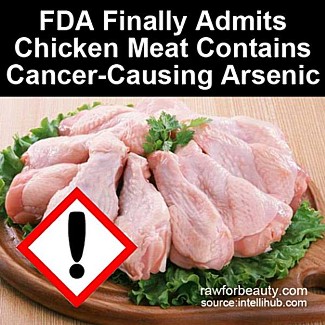Center for Food Safety Pressuring FDA to Create New Regs to Limit Cumulative Arsenic Exposure
 December 30, 2013
December 30, 2013  Kyriaki (Sandy) Venetis
Kyriaki (Sandy) Venetis The Center for Food Safety (CFS) has been pressuring the U.S. Food and Drug Administration for years on various fronts to create more concrete regulations to protect Americans from exposure to arsenic found in common grains like rice, produce such as apples and grapes, and drinks including water and fruit juices.

In its most recent action, the CFS has filed a lawsuit against the FDA calling for the withdrawal of arsenic containing feed additives for chickens, turkeys, and hogs.
The CFS has given one of the best explanations of what arsenic is. It’s an odorless and tasteless semi-metal element that occurs in the environment as part of the earth’s crust.
Arsenic can be found in rocks, soil, water, air, plants, and animals, and can be released into the environment through natural processes such as volcanic eruptions, rocks eroding, forest fires, and human activities. Arsenic can appear in inorganic and organic forms.
The CFS says that at one time, organic arsenic was considered less toxic than inorganic arsenic and safe at low levels, which has now been proven wrong.
The non-profit adds that, “Recent studies show that organic arsenic can easily convert to inorganic arsenic in the environment and in the body when ingested by humans and animals.”
Inorganic arsenic, according to the Centers for Disease Control and Prevention (CDC), is formed when elemental arsenic in the environment is combined with oxygen, chlorine, and sulfur. Inorganic arsenic is a known carcinogen, but can cause a host of other health problems as well.
The FDA says that, “Long-term exposure to high levels of arsenic is associated with higher rates of skin, bladder, and lung cancers, as well as heart disease.” The CDC adds that arsenic can also affect the digestive system, liver, nervous system, and respiratory system from the nose to the lungs.
Research at the CFS has found that “children, infants, and fetuses are among the most vulnerable to arsenic’s toxic effects” due to the differences in their metabolism from adults early in life.
The non-profit added that, “Carcinogens like arsenic are generally more potent in early life exposures” and that, “Children ages two to five are three times more vulnerable to carcinogens than adults.”
The CFS went on to say that evidence shows that arsenic is a hormone disruptor at very low levels, which can alter the way that hormones transmit information between cells.
Consumer Reports, through its own research also explained how arsenic exposure can affect a child saying that, “when arsenic exposure occurs in the womb or in early childhood, it not only increases cancer risks later in life, but also can cause lasting harm to children’s developing brains and endocrine and immune system, leading to other diseases, too.”
